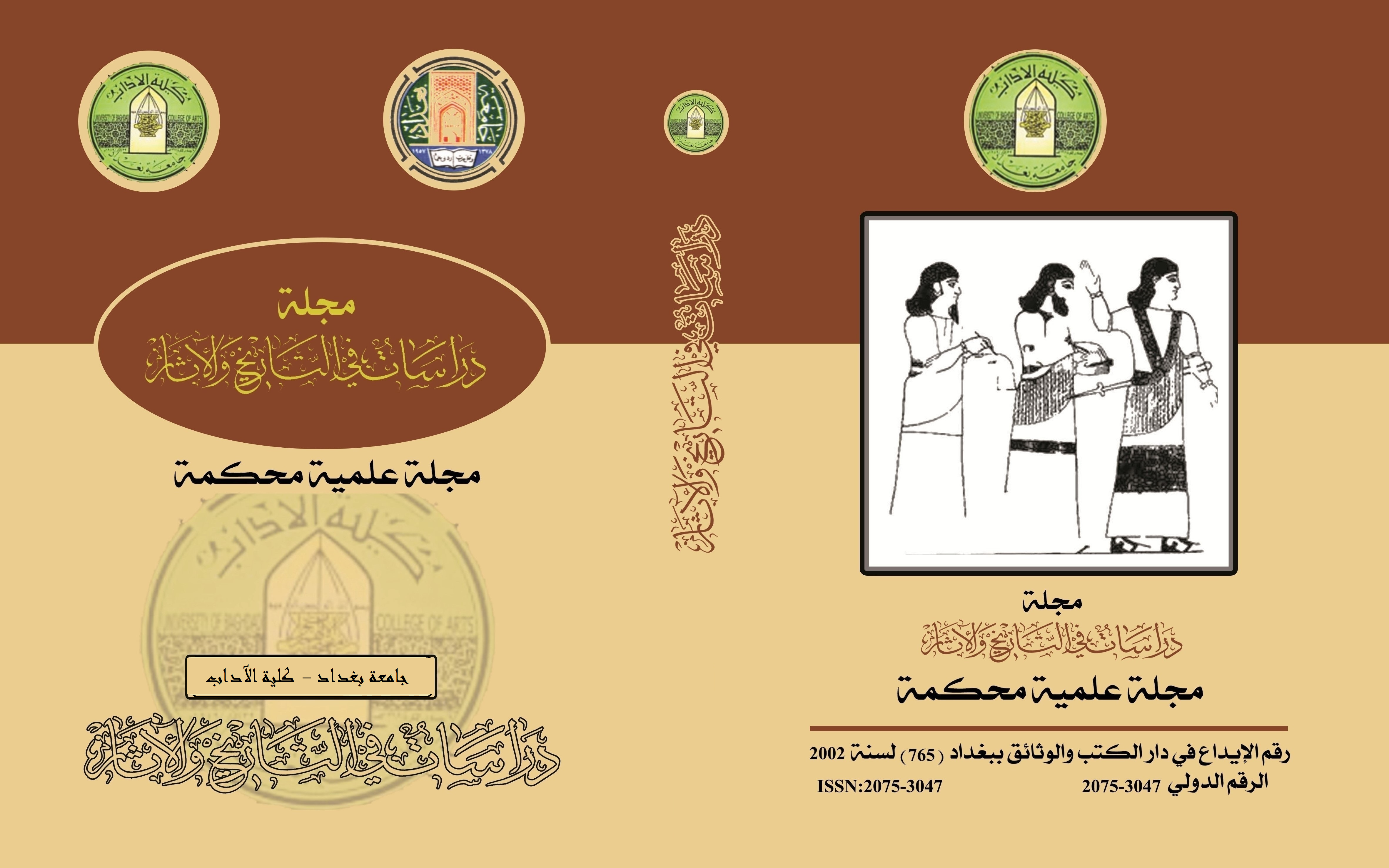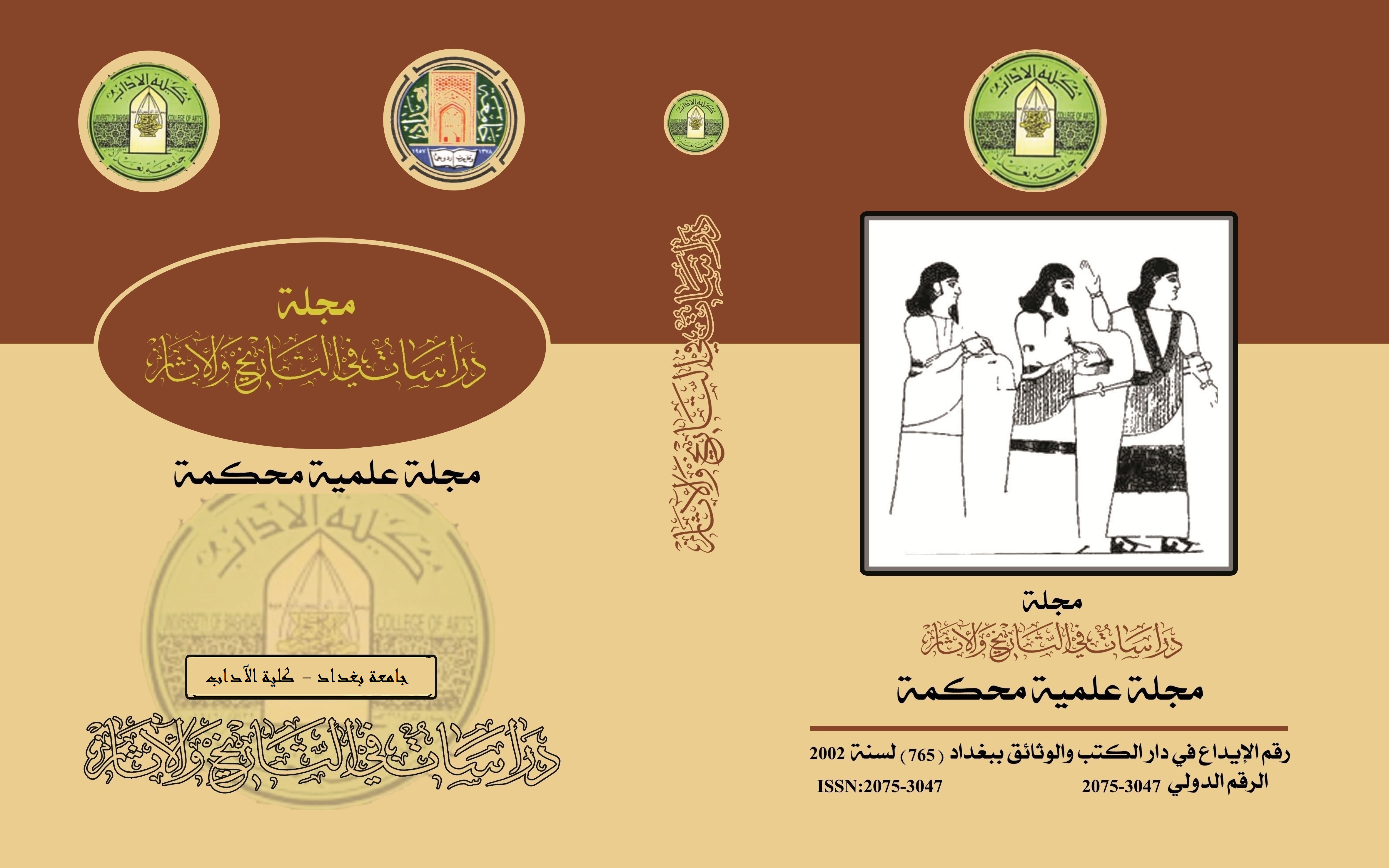العطور في المصادر المسمارية
الكلمات المفتاحية:
عطار، عطر، نبات عطريالملخص
تعد معلوماتنا المتوفرة عن العطور والتي تؤكد أن سكان بلاد الرافدين قد وضعوا فكرة عن الجمال واذواق الناس والتي تخدم وترفع من حياة الانسان على نحو عام، حيث ان المصادر المسمارية التي دونت بواسطتها كلمة عطر وهي مقياس الجمال في حياة الانسان بقوة ومعطر بأجمل العطور، في البداية نوضح ما يشير إلى ان سكان بلاد الرافدين قد امتلكوا العديد من المعارف والعلوم بعد ان تعرفوا على طبيعة بيئتهم وكيفية التعامل معها واستخدام ما يحيط بهم، حيث تطورت المعارف والعلوم ومنها علوم الكيمياء، وعدت العطور من المواد الثانوية المكملة لبناء اقتصاد المجتمعات القديمة سواء في المجال الصناعي او التجاري، وكذلك في المجال الديني، إذ استعملت في الطقوس الدينية التي تقام في المعابد، إذ يقوم المعبد بتوفير احتياجاته من العطور وذلك باستيرادها من المناطق المتوفرة لأغراض اقامة الشعائر والطقوس الدينية وتطهير وتعطير اماكن الطقوس في المعابد وأيضاً في القصور الملكية، إضافة الى ذلك استعملت العطور في الحياة اليومية في مناسبات عدة ومنها (الاعمال العمرانية، وصناعة الصابون والمنظفات، والدباغة، وتركيب الادوية واعداد الوصفات العلاجية، والانارة). ولا بد من القول أن الرجال في مدينة بابل استعملوا العطور بكثرة، إذ لا نملك نص تاريخي يشير الى استعمال العطور في تلك الفترة، وتضمنت مادة البحث محورين: المحور الاول: العطور لغة واصطلاحاً وتسميتها في المصادر المسمارية، والمحور الثاني: استعمالات العطور.
المراجع
ابن منظور، محمد بن مكرم بن علي ابو الفضل جمال الدين، (د.ت)، معجم لسان العرب، بيروت.
أحمد، سهيلة مجيد، (2013)، من الثقافات الشعبية صناعة العطور في العراق القديم، مجلة التربية والعلم، المجلد 20، العدد 3، الموصل.
أحمد، سهيلة مجيد، (2020)، صناعة الصابون في العراق القديم، مجلة الملوية للدراسات الآثارية والتاريخية، المجلد7، العدد20، السنة السابعة.
أوتس، جون (1990)، بابل تاريخ مصور، ترجمة: سمير عبد الرحيم الجلبي، دائرة الآثار والتراث.
الجادر، وليد (1985)، الازياء والآثاث، حضارة العراق، ج2، بغداد.
الجبوري، علي ياسين، (2010)، قاموس اللغة الاكدية – العربية، ط1، ابو ظبي.
الجنابي، جاسم عبد الأمير جاسم، (2018)، نصوص ادارية غير منشورة من (2112-2004 ق.م)، اطروحة دكتوراه غير منشورة، جامعة بغداد، كلية الآداب، قسم الآثار.
الحميداوي، وجدان ناصر حسين (2015)، نصوص اقتصادية ادارية غير منشورة من زمن سلالة أور الثالثة (2112-2004 ق.م)، رسالة ماجستير غير منشورة، جامعة بغداد، كلية الآداب، قسم الآثار.
الخفاجي، نور حميد حسون (2018)، نصوص اقتصادية من سلالة أور الثالثة (مصادرة)، رسالة ماجستير غير منشورة، جامعة بغداد، كلية الآداب، قسم الآثار.
دالي، ستيفاني (2011)، اساطير بلاد ما بين النهرين (الخليقة – الطوفان – كلكامش وغيرهم)، ترجمة: نجوى نصير، ط2، بيروت.
الدليمي، أنغام سليم محمد (2018)، نصوص مسمارية غير منشورة من العصر السومري الحديث (2112-2004 ق.م)، رسالة ماجستير غير منشورة، جامعة بغداد، كلية الآداب، قسم الآثار.
الدليمي، مؤيد محمد سليمان جعفر (2001)، الاوزان في العراق القديم في ضوء الكتابات المسمارية المنشورة وغير المنشورة، رسالة ماجستير غير منشورة، جامعة الموصل، كلية الآداب، قسم الآثار.
الرازي، محمد بن ابي بكر عبد القادر، (2008)، مختار الصحاح، القاهرة.
سليمان، عامر، عبد الواحد، فاضل (1979)، عادات وتقاليد الشعوب القديمة، بغداد.
الشواف، قاسم (1996)، ديوان الاساطير، سومر وأكد وآشور، الكتاب الأول، ط1، بيروت.
صالح، جلال محمد (1997)، كيمياء وصناعة العطور عبر التاريخ، مجلة المجمع العلمي العراقي، العدد3، بغداد.
عبد، حيد عقيل (2014)، نصوص اقتصادية غير منشورة من عهد الملك ابي – سين (2028-2004ق.م)، رسالة ماجستير غير منشورة، جامعة بغداد، كلية الآداب، قسم الآثار.
عطية، كاظم عبد الله (2008)، الولائم في المصادر المسمارية، مجلة كلية الآداب، جامعة بغداد، العدد 83، بغداد.
علي، فاضل عبد الواحد (1989)، الاعياد والاحتفالات، حضارة العراق، ج1، بغداد.
الفيروزابادي، مجد الدين محمد بن يعقوب، (2009)، القاموس المحيط، ط1، مكتبة الإيمان، المنصورة.
كريمر، صموئيل نوح (1973)، السومريون تاريخهم – حضارتهم وخصائصهم، ترجمة: فيصل الوائلي، الكويت.
لابات، رينيه، (2004)، قاموس العلامات المسمارية، ترجمة: الاب البير ابونا وآخرون، بغداد.
اللامي، صابرين قاسم رشيد (2012)، نصوص اقتصادية غير منشورة من زمن الملكين شو سين وابي – سين (2038-2004 ق.م)، رسالة ماجستير غير منشورة، جامعة بغداد، كلية الآداب، قسم الآثار.
ليفي، مارتن (1980)، الكيمياء والتكنولوجيا الكيميائية في وادي الرافدين، ترجمة: محمود فياض المياحي وآخرون، بغداد.
الماجدي، خزعل (1998)، متون سومر، لبنان.
محسن، علي حسين (2019)، نص مواد عطرية من سلالة أور الثالثة في المتحف العراقي، مجلة القادسية للعلوم الانسانية، المجلد 22، العدد1، جامعة القادسية، كلية الآداب.
محسن، هالة عبد الأمير (2011)، الملكية ونظرية الزواج المقدس في العراق القديم (2800-1595 ق.م)، رسالة ماجستير غير منشورة، جامعة بغداد، كلية الآداب، قسم التاريخ.
منظور، نجيبة، (2015)، العطور وأحكامها في الفقه الاسلامي، دراسة فقهية مقارنة، رسالة ماجستير، جامعة الشهيد حمد الخضر، الوادي.
النعيمي، صفاء عبد الكريم حيدر، (2015)، دراسة نصوص اقتصادية غير منشور من عصر أور الثالثة (2112 – 2004 ق.م)، رسالة ماجستير، غير منشورة، جامعة بغداد، كلية الآثار.
Foxvog, D.A. and Kilmer, A.N, ''benno landsbergers lexicographical contributions'', JCS, vol. 27, No.1, 1975.
edzard, D. and Farber, G, Die orts - und Gewässer hamer dey 3 - Dynastie von Ur, Wiesbaden, 1974.
Nawala Al-MutalNalli and Walther Sallaberger with a contrition by Ali Ubeid shalk ham., “The cuneiform Documents from the Iraqi Excavation at Drehem”, ZA, (2017), 107(2).
Faster, B. R., Commercial Activity in Mesopotamia, Iraq, Vol.39, 1977.
Greengus, S., ''old Babylonian marriag, ceremonies and rites''; JCS, vol. 20, No. 2 (1966).
Forber, G., “Another old Babylonian childbirth Incantation”, JNES, Vol.43, No.4, (Chicage, 1984).
Langendor Fey, B.A., Who Buils Assyria: Nurture and Control at sennacherib's Great Relief at Khinnis, (Austin).
Borager, R., ''Die Inschriften Asarhaddons konigs von Assyrien, (osnatruck, 1967), v5.
Patrick, Donald, P, The Imperial Gardens of Mesopotamia: Landscapes of power, (London, 2016).
Gelb, I.J & others, (1956). The oriental institute of the university of Chicago.
Black, J & others. (2000): A concist Dictionary of Akkadian, (Wiesbaden).
Sources:
Ibn Manzur, Muhammad bin Makram bin Ali Abu al-Fadl Jamal al-Din, (dt), The Lexicon of Lisan al-Arab, Beirut.
Ahmed, Suhaila Majeed, (2013), From Folk Cultures Perfume Industry in Ancient Iraq, Journal of Education and Science, Volume 20, Issue 3, Mosul.
Ahmad, Suhaila Majeed, (2020), Soap Industry in Ancient Iraq, Al-Malwiya Journal for Archaeological and Historical Studies, Volume 7, Issue 20, Year Seven.
Oates, John (1990), Babylon, an illustrated history, translated by: Samir Abdel-Rahim Chalabi, Department of Antiquities and Heritage.
Al-Jader, Walid (1985), Fashion and Furniture, The Civilization of Iraq, Part 2, Baghdad.
Al-Jubouri, Ali Yassin, (2010), Akkadian Language Dictionary - Arabic, 1st Edition, Abu Dhabi.
Al-Janabi, Jassim Abdul-Amir Jassim, (2018), unpublished administrative texts from (2112-2004 BC), unpublished doctoral thesis, University of Baghdad, College of Arts, Department of Archeology.
Al-Hamidawi, Wijdan Nasir Hussain (2015), unpublished economic and administrative texts from the time of the Third Dynasty of Ur (2112-2004 BC), unpublished MA Thesis, University of Baghdad, College of Arts, Department of Archeology.
Al-Khafaji, Nour Hamid Hassoun (2018), Economic Texts from the Third Dynasty of Ur (Confiscation), Unpublished Master Thesis, University of Baghdad, College of Arts, Department of Archeology.
Daly, Stephanie (2011), Myths of Mesopotamia (Creation - the Flood - Gilgamesh and others), translated by: Najwa Nasir, 2nd Edition, Beirut.
Al-Dulaimi, Angham Selim Muhammad (2018), unpublished cuneiform texts from the modern Sumerian era (2112-2004 BC), unpublished master's thesis, University of Baghdad, College of Arts, Department of Archeology.
Al-Dulaimi, Muayyad Muhammad Suleiman Jaafar (2001), Weights in Ancient Iraq in Light of Published and Unpublished Cuneiform Writings, Unpublished Master Thesis, University of Mosul, College of Arts, Department of Archeology.
Al-Razi, Muhammad Ibn Abi Bakr Abd al-Qadir, (2008), Mukhtar As-Sahha, Cairo.
Suleiman, Amer, Abdul Wahid, Fadel (1979), The Customs and Traditions of Ancient Peoples, Baghdad.
Al-Shawaf, Qasim (1996), Divan of Legends, Sumer Wakad and Assyria, Book One, First Edition, Beirut.
Saleh, Jalal Muhammad (1997), Chemistry and Perfumery through History, Journal of the Iraqi Scientific Complex, Issue 3, Baghdad.
Abd, Hayd Aqeel (2014), unpublished economic texts from the era of King Abi-Sin (2028-2004 BC), unpublished master's thesis, University of Baghdad, College of Arts, Department of Archeology.
Attia, Kazem Abdullah (2008), The Banquets in Cuneiform Sources, Journal of the College of Arts, University of Baghdad, Issue 83, Baghdad.
Ali, Fadel Abdul Wahid (1989), Festivals and Celebrations, The Civilization of Iraq, Part 1, Baghdad.
Al-Fayrouzabadi, Majd Al-Din Muhammad Ibn Ya`qub, (2009), Al-Qamoos Al Muheet, 1st Edition, Faith Library, Mansoura.
Kremer, Samuel Noah (1973), The Sumerians, their history - their civilization and their characteristics, translated by: Faisal Al-Waeli, Kuwait.
Labat, Rene, (2004), Dictionary of Cuneiform Signs, translated by: Father Albert Abuna et al., Baghdad.
Al-Lami, Sabrin Qasim Rashid (2012), Unpublished Economic Texts from the Time of the Two Kings Shu Sen Wabi-Sen (2038-2004 BC), Unpublished Master Thesis, University of Baghdad, College of Arts, Department of Archeology.
Levy, Martin (1980), Chemistry and Chemical Technology in Mesopotamia, translated by: Mahmoud Fayyad Al-Mayahi et al., Baghdad.
Al-Majidi, Khazal (1998), Maton Sumer, Lebanon.
Mohsen, Ali Hussain (2019), Text of Aromatic Materials from the Third Dynasty of Ur in the Iraqi Museum, Al-Qadisiyah Journal for Human Sciences, Volume 22, Issue 1, Al-Qadisiyah University, College of Arts.
Mohsen, Hala Abdul-Amir (2011), Monarchy and the Theory of Holy Marriage in Ancient Iraq (2800-1595 BC), unpublished MA Thesis, University of Baghdad, College of Arts, Department of History.
Manzour, Najeebah, (2015), Perfumes and their provisions in Islamic jurisprudence, a comparative jurisprudence study, master's thesis, Shahid Hamad Al-Khader University, Wadi.
Al-Nuaimi, Safa Abd al-Karim Haydar, (2015), a study of unpublished economic texts from the Ur III era (2112 - 2004 BC), an unpublished master's thesis, University of Baghdad, College of Archeology.
Foxvog, D.A. and Kilmer, A.N, ''benno landsbergers lexicographical contributions'', JCS, vol. 27, No.1, 1975.
edzard, D. and Farber, G, Die orts - und Gewässer hamer dey 3 - Dynastie von Ur, Wiesbaden, 1974.
Nawala Al-MutalNalli and Walther Sallaberger with a contrition by Ali Ubeid shalk ham., “The cuneiform Documents from the Iraqi Excavation at Drehem”, ZA, (2017), 107(2).
Faster, B. R., Commercial Activity in Mesopotamia, Iraq, Vol.39, 1977.
Greengus, S., ''old Babylonian marriag, ceremonies and rites''; JCS, vol. 20, No. 2 (1966).
Forber, G., “Another old Babylonian childbirth Incantation”, JNES, Vol.43, No.4, (Chicage, 1984).
Langendor Fey, B.A., Who Buils Assyria: Nurture and Control at sennacherib's Great Relief at Khinnis, (Austin).
Borager, R., ''Die Inschriften Asarhaddons konigs von Assyrien, (osnatruck, 1967), v5.
Patrick, Donald, P, The Imperial Gardens of Mesopotamia: Landscapes of power, (London, 2016).
Gelb, I.J & others, (1956). The oriental institute of the university of Chicago.
Black, J & others. (2000): A concist Dictionary of Akkadian, (Wiesbaden).
التنزيلات
منشور
إصدار
القسم
الرخصة

هذا العمل مرخص بموجب Creative Commons Attribution 4.0 International License.
:حقوق الطبع والنشر والترخيص
بالنسبة لجميع البحوث المنشورة في مجلة دراسات في التاريخ والآثار، يحتفظ الباحثون بحقوق النشر. يتم ترخيص البحوث بموجب ترخيص Creative Commons CC BY 4.0 المفتوح ، مما يعني أنه يجوز لأي شخص تنزيل البحث وقراءته مجانًا. بالإضافة إلى ذلك ، يجوز إعادة استخدام البحث واقتباسه شريطة أن يتم الاستشهاد المصدر المنشور الأصلي. تتيح هذه الشروط الاستخدام الأقصى لعمل الباحث وعرضه.
:إعادة إنتاج البحوث المنشورة من الناشرين الآخرين
من الضروري للغاية أن يحصل الباحثون على إذن لإعادة إنتاج أي بحث منشورة (أشكال أو مخططات أو جداول أو أي مقتطفات من نص) لا يدخل في نطاق الملكية العامة أو لا يملكون حقوق نشرها. يجب أن يطلب الباحثون إذنًا من مؤلف حقوق النشر (عادة ما يكون الناشر).
يطلب الإذن في الحالات التالية:
بحوثك الخاصة المنشورة من قِبل ناشرين آخرين ولم تحتفظ بحقوق النشر الخاصة بها.
مقتطفات كبيرة من بحوث أي شخص أو سلسلة من البحوث المنشورة.
استخدم الجداول والرسوم البيانية والمخططات والمخططات والأعمال الفنية إذا لم يتم التعديل عليها.
الصور الفوتوغرافية التي لا تملك حقوق لنشرها.
لا يطلب الإذن في الحالات التالية:
إعادة بناء الجدول الخاص بك مع البيانات المنشورة بالفعل في مكان آخر. يرجى ملاحظة أنه في هذه الحالة يجب عليك ذكر مصدر البيانات في شكل "بيانات من ..." أو "مقتبس من ...".
تعتبر عروض الأسعار القصيرة معقولة الاستخدام العادل ، وبالتالي لا تتطلب إذنًا.
الرسوم البيانية ، الرسوم البيانية ، المخططات ، الأعمال الفنية التي أعاد الباحث رسمها بالكامل والتي تم تغييرها بشكل ملحوظ إلى درجة لا تتطلب الاعتراف.
الحصول على إذن
لتجنب التأخير غير الضروري في عملية النشر ، يجب أن تبدأ في الحصول على أذونات في أقرب وقت ممكن. لا يمكن لمجلة الآداب نشر بحث مقتبس من منشورات أخرى دون إذن.
قد يمنحك مالك حقوق الطبع والنشر تعليمات بشأن شكل الإقرار الواجب اتباعه لتوثيق عمله ؛ بخلاف ذلك ، اتبع النمط: "مستنسخ بإذن من [المؤلف] ، [كتاب / المجلة] ؛ نشره [الناشر] ، [السنة]." في نهاية شرح الجدول ، الشكل أو المخطط.



















